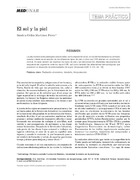Mostrar el registro sencillo del ítem
El sol y la piel
| dc.contributor.author | Martínez Pérez, Sandra Otilia | spa |
| dc.date.accessioned | 2020-10-27T14:22:33Z | |
| dc.date.available | 2020-10-27T14:22:33Z | |
| dc.date.issued | 2002-05-10 | |
| dc.identifier.issn | 2382-4603 | |
| dc.identifier.issn | 0123-7047 | |
| dc.identifier.uri | http://hdl.handle.net/20.500.12749/10559 | |
| dc.description.abstract | La alta incidencia de patologías relacionadas con la exposición al sol, en los últimos tiempos ha centrado nuestro interés en el estudio de los diferentes tipos de piel y cómo los UVR afectan su constitución normal. En esta revisión se clasifican los tipos de piel y se mencionan los diferentes mecanismos de respuesta del organismo ante los rayos UVR, así como también las alternativas farmacológicas que previenen el desarrollo de enfermedades de la piel | spa |
| dc.format.mimetype | application/pdf | spa |
| dc.language.iso | spa | spa |
| dc.publisher | Universidad Autónoma de Bucaramanga UNAB | |
| dc.relation | https://revistas.unab.edu.co/index.php/medunab/article/view/298/281 | |
| dc.relation.uri | https://revistas.unab.edu.co/index.php/medunab/article/view/298 | |
| dc.rights.uri | http://creativecommons.org/licenses/by-nc-nd/2.5/co/ | |
| dc.source | MedUNAB; Vol. 5 Núm. 13 (2002): Migraña, Sol y piel, Aracnoidismo; 44-50 | |
| dc.subject | Ciencias biomédicas | |
| dc.subject | Ciencias de la vida | |
| dc.subject | Innovaciones en salud | |
| dc.subject | Investigaciones | |
| dc.title | El sol y la piel | spa |
| dc.title.translated | The sun and the skin | eng |
| dc.publisher.faculty | Facultad Ciencias de la Salud | spa |
| dc.publisher.program | Pregrado Medicina | spa |
| dc.type.driver | info:eu-repo/semantics/article | |
| dc.type.local | Artículo | spa |
| dc.type.coar | http://purl.org/coar/resource_type/c_6501 | |
| dc.subject.keywords | Health Sciences | eng |
| dc.subject.keywords | Medicine | eng |
| dc.subject.keywords | Medical Sciences | eng |
| dc.subject.keywords | Biomedical Sciences | eng |
| dc.subject.keywords | Life Sciences | eng |
| dc.subject.keywords | Innovations in health | eng |
| dc.subject.keywords | Research | eng |
| dc.subject.keywords | Ultraviolet radiation | spa |
| dc.subject.keywords | Photodamage | eng |
| dc.subject.keywords | Photoprotection | eng |
| dc.identifier.instname | instname:Universidad Autónoma de Bucaramanga UNAB | spa |
| dc.type.hasversion | Info:eu-repo/semantics/publishedVersion | |
| dc.type.hasversion | info:eu-repo/semantics/acceptedVersion | spa |
| dc.rights.accessrights | info:eu-repo/semantics/openAccess | spa |
| dc.relation.references | Hawk JLM. Cutaneous photobiology. In: Rook N, WilkinsonJ, Ebling P. Text Book of Dermatology. Oxford, Champion,Burton & Ebling, 1998: 973-93 | spa |
| dc.relation.references | Habif P. Clinical dermatology, 3 ed, Mosby-Year Book, 1996.In 11409194/view/525" http://home.mdconsult.com/das/book/11409194/view/525 | spa |
| dc.relation.references | Lim HW, Naylor M, Honigsmann H, et al. American Academyof Dermatology Consensus Conferencia in UVA protection ofsunscreens: Summary and recommendations, J Am AcadDermatol 2001; 505-8 | spa |
| dc.relation.references | Levy SB. Sunscreens and photoprotection. eMed J Dermatol2000; 1 (4). In: derm/topic510.htm”http://www.emedicine.com/derm/topic510.htm | spa |
| dc.relation.references | Kochevar IE, Pathak MA, Parrish JA. Photochemical,photophysical and photobiology. In: Fitzpatrick T, Eisen A,Wolff K, et al (eds). Dermatology in general medicine. NewYork, McGraw Hill, 1999: 1627-38 | spa |
| dc.relation.references | aylor CH, Stern R, Leyden J. Photoaging, photodamage andphotoprotection. J Am Acad Dermatol 1990; 22:1-15 | spa |
| dc.relation.references | Levy S.B. Sunscreens for photoprotection. Dermatol Ther1997; 4:59-71 | spa |
| dc.relation.references | Hoffman K, Kaspar K, Gambichles T, et al. In vitro and in vivodetermination of the UV protection factor for light weight cottonand viscose summer fabrics. A preliminary study. J Am AcadDermatol 2000; 43:1009-16 | spa |
| dc.relation.references | MacLean DI, Gallagher R. Sunscreens (use and misuse).Dermatol Clin 1998; 16: 219-26 | spa |
| dc.subject.lemb | Ciencias médicas | spa |
| dc.subject.lemb | Ciencias de la salud | spa |
| dc.subject.lemb | Medicina | spa |
| dc.identifier.repourl | repourl:https://repository.unab.edu.co | |
| dc.description.abstractenglish | The high incidence of pathologies related to sun exposure in recent times has focused our interest on the study of different skin types and how UVR affects its normal constitution. This review classifies skin types and mentions the different response mechanisms of the body to UVR rays, as well as pharmacological alternatives that prevent the development of skin diseases. | eng |
| dc.subject.proposal | Radiación ultravioleta | spa |
| dc.subject.proposal | Fotodaño | spa |
| dc.subject.proposal | Fotoprotección | spa |
| dc.type.redcol | http://purl.org/redcol/resource_type/ART | |
| dc.rights.creativecommons | Atribución-NoComercial-SinDerivadas 2.5 Colombia | * |
Ficheros en el ítem
Este ítem aparece en la(s) siguiente(s) colección(ones)
-
Revista MedUNAB [817]


